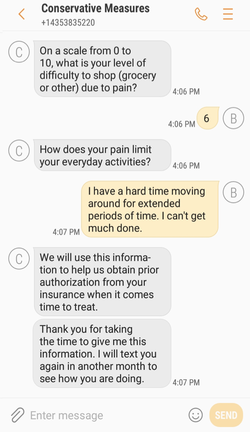by Blake Nelson, BS, Carl M. Black, MD and Dan Corey, MD
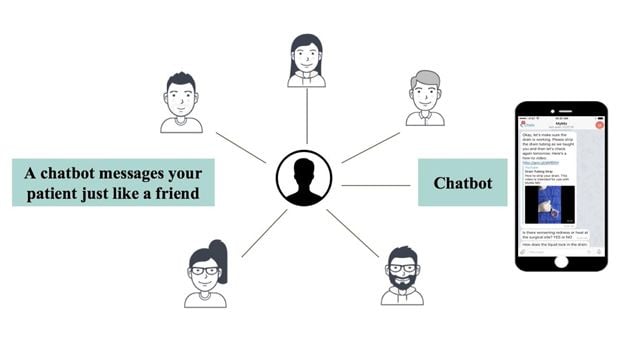
Laura is now two days out from a combined GSV ablation (EVLA) with ambulatory phlebectomy (AP). Ivy, her personal medical chatbot, checks in on her.
“Hi Laura, Ivy here, just checking in on you . . .” (fig.1).
Figure 1. Sample chatbot interactions following combined EVLA with AP.
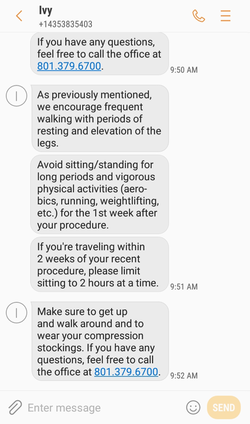
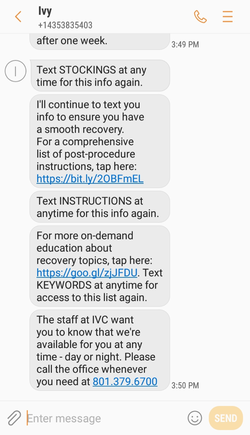
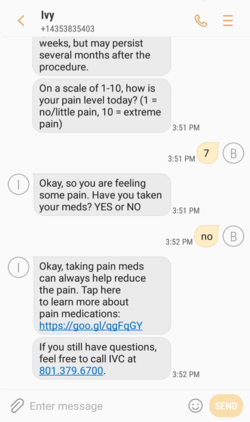
Calmed by the instructions, Laura feels she will have a quick recovery and appreciates the follow-up interaction with her treating physician’s office. On post-op day three, she is experiencing increased pain. The chatbot asks follow-up questions to ensure full compliance with postoperative instructions.
In this case, Laura is not properly medicating, which is contributing to her pain. The chatbot sends additional instructions on how to medicate properly and instructs her to call the office if she still has questions.
Without these interactions, Laura may have waited several days, enduring unnecessary pain. Through chatbot technology, Laura was more compliant with her postoperative instructions and able to receive timely reassurance and answers to her questions.
Another patient, Susan, has suffered from leg pain and swelling for nearly five years since her last pregnancy. Her insurance provider mandates a 90-day trial of conservative measures, including compression stockings and NSAIDs, before she would be eligible for ablation of her incompetent greater saphenous vein.
Before adopting chatbot digital assistant technology, the office staff would have called for an update every 30 days to document her compliance with pre-authorization measures. Patients were often unavailable, busy, or unable to answer the phone at the time of the call, making follow-up challenging for office staff.
Through the use of a chatbot, Susan was able to self-report pain and impact on her daily activity, along with her compliance with recommended conservative measures at her convenience (fig. 2).
Figure 2. Conservative measures sample interaction.

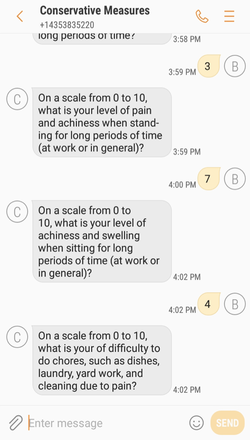
Applications in Chronic Venous Insufficiency
These highlighted scenarios illustrate the potential role of chatbots in helping patients navigate through the evaluation and management of their chronic venous insufficiency. Chatbots can assist in post-procedural care following EVTA, AP, ultrasound-guided foam sclerotherapy, and spider vein treatment.
Chatbots can also aid in promoting adherence to and documenting compliance with pre-authorization insurance requirements such as a trial of pre-procedure conservative measures. Individual care summaries can be incorporated into a patient’s electronic medical record.
A typical post-treatment venous chatbot runs for seven days and includes important information regarding recovery, appropriate activity, and risk-reduction measures. The chatbot promotes appropriate activity by encouraging frequent walking with periods of rest and leg elevation.
If the patient desires, they can text certain keywords into the chatbot to get more detailed information. For example, if the patient texts “stockings” at any time, they will receive use instructions regarding optimal duration and tips for effective use.
Chatbots as a Physician Extender
A chatbot may soon be one of your critical physician extenders, helping you digitally leverage your expertise and reduce practice expenses, while improving patient satisfaction, compliance and outcomes.
Chatbots simulate text-based conversation in a familiar, personal format, allowing physicians to reinforce care processes beyond traditional care models—virtually any hour of the day (fig. 3).
Why is this important?
Many patients leave a doctor’s office with an extensive amount of information, only to later have questions and misunderstandings that could compromise their care. Such information voids can be at least partially alleviated through the integration of chatbot technology into the care process.
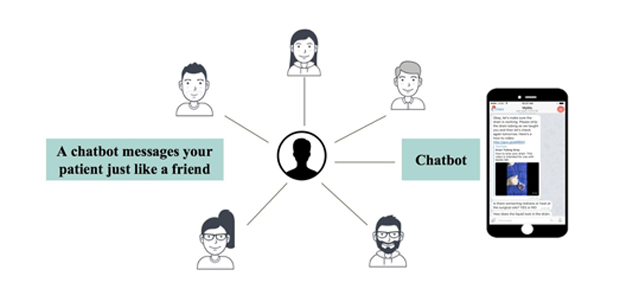 Figure 3. Chatbot messaging blends into a patient’s existing social network.
Figure 3. Chatbot messaging blends into a patient’s existing social network.
It is estimated that patient non-compliance increases health care costs by an estimated $100 billion, causes approximately 125,000 deaths, and accounts for over 10% of hospital and nursing home admissions annually in the United States.1-4
The Centers for Disease Control and Prevention estimates that the total “economic burden” of prescription opioid misuse alone in the United States is $78.5 billion a year, including the costs of health care, lost productivity, addiction treatment, and criminal justice involvement.5
Chatbots promise to decrease the cost of health care by educating patients and encouraging them to make healthy choices, which increases the likelihood of better patient outcomes.
Effectiveness of Chatbots
Early research conducted to assess the effectiveness of chatbots is promising. In a randomized controlled trial looking at the delivery of cognitive behavior therapy in young adults with symptoms of depression and anxiety, chatbots were shown to positively impact care.
US university college students who self-identified as having symptoms of depression and anxiety were recruited and randomized into two different groups.
One group received daily encouragement and specifically-tailored cognitive behavior therapy from a chatbot. The control group was directed to an e-book called Depression in College Students. This e-book provided information on signs and symptoms of depression, different treatments, and answers to frequently asked questions about depression.
The study was conducted over a two-week period. Results were measured by differences in pre- and post-study questionnaires. Results showed a significant decrease in depressive symptoms for the chatbot group compared to the control group. With some reservations, this study substantiated that the implementation of chatbots into the medical field can have a positive impact on patient care.6
Integration of Chatbots into Your Practice
Chatbots promise to substantially reduce unnecessary redundant communication between patients and clinical personnel while facilitating essential patient-to-provider communication. Chatbots can alert patients and medical staff with time-sensitive information to guide and tailor care. A chatbot can also deliver timely education and obtain feedback based on a patient’s specific responses to evidence-based questions.
If the chatbot module does not have a response to a specific question, the question is forwarded to their provider to facilitate contact. Or, if person-to-person communication is the patient’s preference for a specific situation, chatbots can facilitate direct communication with the patient’s provider and office.
Chatbots are designed with safety net measures that reinforce prescribed care. The ability to know real-time if patients are taking their medication appropriately, especially those medications with potentially addictive qualities such as opioids, also opens the door to the prevention of addiction and misuse.
With an increasing focus on value-based care, chatbots can also help providers with patient-specific follow-up care schedules rather than the generic “come back in two-weeks” approach. Patients will have a digital assistant that, based on their individual responses to evidence and time-based questions, keeps them and their doctors up to date on next steps in their care process.
Many different media options can be embedded into the chatbot, including video, links to educational websites, links to existing tools from your office, or links to documents already created specifically for a particular care process.
Measures can be taken to safeguard private patient health information when chatbot exchanges go beyond simple education. A secure text messaging platform, such as Telegram, can be utilized for end-to-end encryption. Figure 4 shows the instructions for downloading Telegram and initiating an encrypted chatbot conversation.
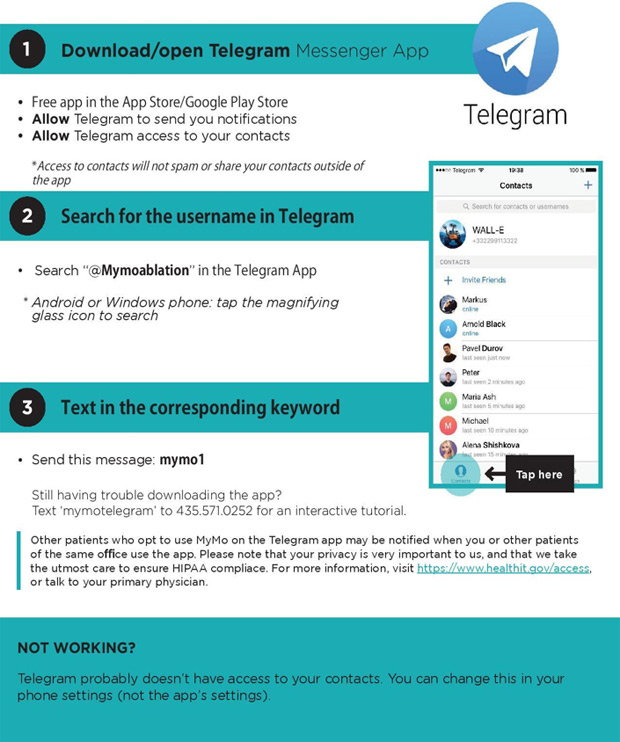 Figure 4. Use of Telegram as an encrypted texting platform.
Figure 4. Use of Telegram as an encrypted texting platform.
Patient feedback is a vital part of the experience and allows for agile ongoing chatbot development and refinement. On the final day of text communication, the chatbot asks for feedback: “This is my last day with you. If you don't mind, I have a few questions. First, how helpful was I to you on a scale of 1 to 5? 1=Not at all, 5=Very helpful.”
After, it texts: “Thank you. Finally, what could I do better to help patients in the future?” Patients have the freedom to respond and offer suggestions to improve the chatbot.
Medical chatbots can be integrated into essentially any practice or care process. Office staff can be easily trained to onboard patients and implement chatbot technology into office protocols. Staff have ready access to a dashboard monitor that allows easy visibility of chatbot-patient interactions.
If a patient texts a question to the chatbot that it does not understand, staff can be alerted or a patient can simply be encouraged to reach out to their provider.
Expanding Applications
MyMoMD.com (Provo, UT) is pushing the envelope of chatbot technology in medical applications, focusing on a broad array of disease states and clinical conditions including pregnancy, joint replacement surgery, opioid management, breast cancer, weight loss, vascular disease, diabetes, and general post-procedural care.
The expanding list of chatbot applications also includes applications in medicine, primary care, surgery, endocrinology, oncology, pain management, spine surgery, sports medicine, and physical therapy. Post-mastectomy care and pregnancy highlight the potential of chatbots to enhance clinical care.
Mastectomy
Breast cancer patients are often overwhelmed as they simultaneously cope with the diagnosis of breast cancer while undergoing surgery and subsequent treatment. Support, education, and close contact with the care team are critical in these cases. Chatbots promise to play a key role.
In coaching a patient through their recovery, a recently developed post-mastectomy chatbot incorporates best practice algorithmic decision-making, images, video, and select content links to help optimize patient education and compliance. Early clinical experience demonstrates a high degree of patient satisfaction, with over an 80% patient interaction rate back to the chatbot.
Patient feedback has been positive: “It’s been a wonderful service. Thank you.” “Keep it up.” “I liked the videos.” This early experience in breast cancer surgery further supports the concept that chatbot technology can be integrated into a wide array of care processes with a high degree of patient satisfaction.7
Pregnancy
An expectant mother will have many questions and experience a variety of physiologic changes. Chatbots can help patients stay better informed and connected to their obstetrician through the provision of time-sensitive communications, reassurance, and trimester-specific education.
Trimester-specific information includes information regarding appropriate exercise, diet, weight gain, recipes, cramping, medications, ultrasounds, sex, gestational diabetes, among other topics. Information is presented around the normal timelines of when an expectant mother would need it, but is accessible at any moment just by texting in a keyword. When warranted, the pregnancy chatbot also facilitates direct provider communication.
Conclusion
The evolution of medical chatbot technology promises to help physicians and other providers digitally leverage their clinical expertise, reduce practice expenses, improve patient satisfaction, increase compliance and optimize outcomes—all while reducing overall costs of care. Physicians and practices should consider elements of their care processes that could benefit from implementing chatbot technology—whether it be in disease prevention, pre-operative care, post-operative care, or in ongoing medical management.
No matter the duration or complexity of a care process, an effective chatbot dialogue can likely be created to fit the needs of the patients and improve care.
References
- Viswanathan M, Golin CE, Jones CD, et al. 2012. Interventions to improve adherence to self- administered medications for chronic diseases in the United States: a systematic review. Ann Intern Med 157:785–95.
- Atreja A, Naresh Bellam N, Levy SR. Strategies to enhance patient adherence: making it simple. Retrieved from https://www.medscape.com/viewarticle/498339_5.
- Smith DL. Compliance packaging: a patient education tool. 1989. Am Pharm NS29(2):42-45, 49-53.
- Rosenbaum L, Shrank WH. 2013. Taking our medicine — improving adherence in the accountability era. N Engl J Med 369:694-695.
- Anson P. (Ed.). 2016. CDC: prescription opioid abuse costs $78.5 billion. Retrieved from https://www.painnewsnetwork.org/stories/2016/9/15/cdc-prescription-opioid-abuse-costs-785-billion-annually.
- Fitzpatrick KK, Darcy A, Vierhile M. 2017. Delivering cognitive behavior therapy to young adults with symptoms of depression and anxiety using a fully automated conversational agent (Woebot): a randomized controlled trial. JMIR Mental Health 4(2). doi:10.2196/mental.7785.
- Tittensor J, Deshazo J. 2018. “Early patient experience using a post-mastectomy chatbot.” Publication pending (2018).
Disclosures
Blake Nelson, BS, is a full-time chatbot script analyst for MyMoMD.com in Provo, UT. He can be reached at [email protected]. Carl Black, MD is an interventional radiologist, medical advisor, and co-founder of MyMoMD.com in Provo, UT. He can be reached at [email protected]. Dan Corey, MD is a staff radiologist at Utah Radiology Associates in Provo, UT and medical advisor to MyMoMD.com. He can be reached at [email protected].

